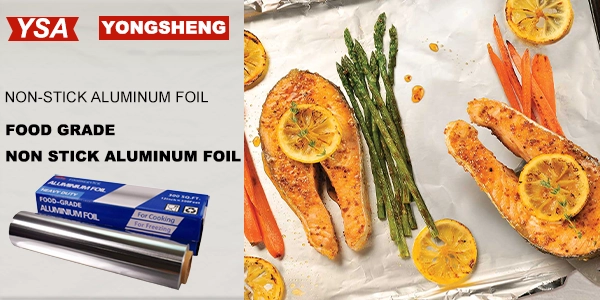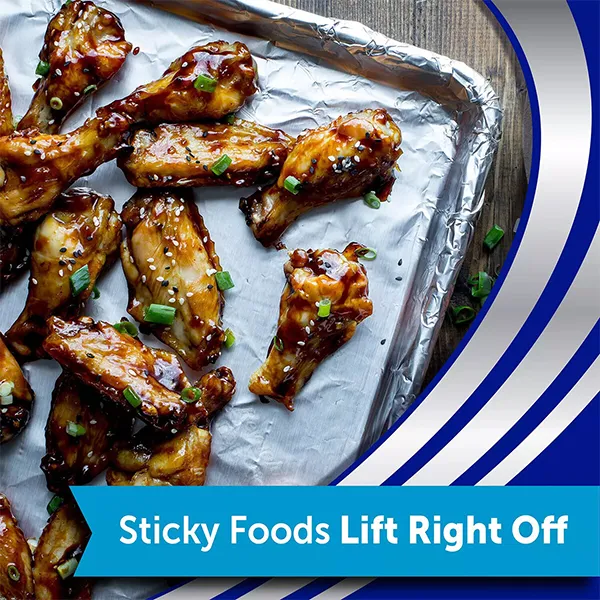Non-stick aluminum foil is highly regarded for its convenience in cooking and baking. Understanding its composition, uses, and potential risks is essential for safe use. This article discusses the safety of nonstick aluminum foil, analyzes its materials, and provides guidelines for safe use.
What Is Non Stick Aluminum Foil
Non stick aluminum foil is a special aluminum foil coated with a non-stick layer. Unlike ordinary aluminum foil, non-stick aluminum foil can prevent food from sticking, which is why it is deeply loved by the baking industry.
Nonstick aluminum foil consists of aluminum foil and non-stick coating.

The secret of the nonstick properties of non stick aluminum foil lies in its coating, which is usually made of silicone or other polymers. No harmful gases are produced during the manufacturing process, which is harmless to workers and more environmentally friendly, forming a smooth, non-reactive surface. In addition, the coating also increases the stretch resistance and flexibility of the aluminum foil.
Non Stick Aluminum Foil Features
Food Grade Safety
The non-stick aluminum foil coating is food-grade and meets international safety standards. It will not contaminate food with high or low temperatures during use and is harmless to the human body. Some people believe that aluminum foil can cause Alzheimer’s disease, but it only occurs when you eat too much aluminum. As long as you don’t use aluminum foil every day, you won’t get mental illness at all.
Non-stick
Non stick aluminum foil is specially coated to prevent food from sticking. No need to apply extra oil to the pan or tray, which will not let your food stick. But for some sticky foods, you’d better apply a little oil, which will enhance the non-stick properties.
Durability
Non-stick aluminum foil is resistant to high temperatures and can be safely used in ovens and grills, and it completely maintains its non-stick properties throughout the grilling process. And it is stronger and tear-resistant.
Safety of Aluminum
- Aluminum Leaching Concerns
Uncoated aluminum foil can react with acidic or salty foods, causing aluminum transfer. However, the World Health Organization (WHO) states that daily aluminum intake from cookware is far below safety thresholds (1–2 mg/kg of body weight).
- Alzheimer’s Disease Links
No conclusive evidence ties aluminum exposure to Alzheimer’s. Major health organizations, including the Alzheimer’s Association, refute this myth.
How Non-Stick Coatings Work
Nonstick coatings work by creating a slippery surface that repels food particles, preventing them from sticking during cooking. The coating is typically made from synthetic polymers that reduce friction, providing a smooth, slippery surface that allows food to easily come off.
The most common coating used on nonstick foil is PTFE. Some manufacturers also use ceramic coatings or silicone-based compounds, which have similar nonstick properties.
The safety of nonstick coatings depends on the chemical. Nonstick foil is safe when used within the recommended temperature range. However, overheating the foil or exposing it to extreme conditions may cause the coating to break down, potentially releasing hazardous substances.
Using Nonstick Foil Potential Risks
| Potential Risks | Prevention |
| Overheating Non-Stick Foil: PTFE coatings degrade at extreme temperatures, releasing fumes that may cause polymer fume fever (temporary flu-like symptoms). | – Use low to medium heat (under 260°C). – Avoid preheating empty foil-lined pans. |
| Potential Risks | Prevention |
| Scratched or Damaged Coatings: Damaged coatings may flake into food. | – Discard heavily scratched foil. |
Is It Safe To Use Nonstick Foil In The Oven
It is safe to use non-stick foil in the oven. Non-stick foil is designed to withstand typical cooking temperatures, but extreme heat can cause the non-stick layer to break down. This can result in the release of harmful chemicals and a reduction in the foil’s non-stick properties.
Safe Use Guidelines for Non-Stick Aluminum Foil
- Temperature Control: Never exceed coating limits (check packaging).
- Avoid Sharp Utensils: Use silicone or wooden tools to preserve coatings.
- Short-Term Use: Ideal for baking, not prolonged marinating.
- Ventilation: Ensure airflow when broiling or grilling.
Therefore, cooking at excessively high temperatures, especially for extended periods of time, increases the risk of coating degradation. Please check the temperature limits of your foil before use.
How To Identify Non-stick Aluminum Foil
The non-stick side of non-stick aluminum foil usually has a different texture or a slightly duller appearance compared to the glossy side of regular aluminum foil. Many brands mark the non-stick side on the packaging or directly on the foil. Check the instructions on the box to see which side should face the food. The non-stick side is usually marked with the word “non-stick.”

FAQs
Q1: Can I use non-stick foil in air fryers?
Yes, but ensure temperatures stay below the coating’s limit (usually 220°C).
Q2: Is it safe to wrap hot foods in non-stick foil?
Briefly storing hot foods is safe, but avoid prolonged contact above 150°C.
Q3: Are non-stick coatings recyclable?
No—coatings hinder recycling. Dispose of coated foil in general waste.
Conclusion
Non-stick aluminum foil, when used correctly, is a safe and efficient kitchen tool. Opt for PFOA-Free PTFE or silicone-coated variants from certified suppliers, adhere to temperature guidelines, and avoid abrasive cleaning.



